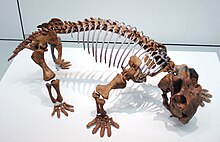
Back Anomodontia Afrikaans أنومودونت Arabic Anomodonts Catalan Anomodontia Czech Anomodontia German Ανομοδόντια Greek Anomodontia Spanish ناهنجاردندان Persian Anomodontia Finnish Anomodontia French
| Anomodontia Temporal range: Middle Permian-Late Triassic,
| |
|---|---|

| |
| Mounted skeleton of Lystrosaurus | |
| Scientific classification | |
| Domain: | Eukaryota |
| Kingdom: | Animalia |
| Phylum: | Chordata |
| Clade: | Synapsida |
| Clade: | Therapsida |
| Suborder: | †Anomodontia Owen, 1859 |
| Subgroups | |




Anomodontia is an extinct group of non-mammalian therapsids from the Permian and Triassic periods.[1] By far the most speciose group are the dicynodonts, a clade of beaked, tusked herbivores.[2] Anomodonts were very diverse during the Middle Permian, including primitive forms like Anomocephalus and Patranomodon and groups like Venyukovioidea and Dromasauria. Dicynodonts became the most successful and abundant of all herbivores in the Late Permian, filling ecological niches ranging from large browsers down to small burrowers. Few dicynodont families survived the Permian–Triassic extinction event, but one lineage (Kannemeyeriiformes) evolved into large, stocky forms that became dominant terrestrial herbivores right until the Late Triassic, when changing conditions caused them to decline, finally going extinct during the Triassic–Jurassic extinction event.
- ^ Liu, J.; Rubidge, B.; Li, J. (2009). "A new specimen of Biseridens qilianicus indicates its phylogenetic position as the most basal anomodont". Proceedings of the Royal Society B. 277 (1679): 285–292. doi:10.1098/rspb.2009.0883. PMC 2842672. PMID 19640887.
- ^ Chinsamy-Turan, A. (2011) Forerunners of Mammals: Radiation - Histology - Biology, p.39. Indiana University Press, ISBN 0253356970. Retrieved May 2012